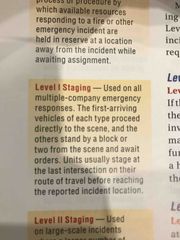![]()
![]()
![]()
Use LEFT and RIGHT arrow keys to navigate between flashcards;
Use UP and DOWN arrow keys to flip the card;
H to show hint;
A reads text to speech;
24 Cards in this Set
- Front
- Back
|
Anchor point |
Point from which a fire line is begun; usually a natural or man-made barrier that prevents fire spread and the possibility of the crew being “flanked” while constructing the Fireline examples include lakes ponds streams roads earlier burns rocks slides and cliffs |
|
|
Base |
Location at which the primary incident management logistics functions are coordinated and administered |
|
|
Cold zone |
Safe area outside the warm zone where equipment and personnel are not expected to become contaminated and special protective clothing is not required; the incident command post and other support functions are typically located in the zone |
|
|
Dual pumping |
Operation where a strong hydrant is used to supply to pumpers by connecting the pumpers intake to intake. The second pump or receive the excess water not being pumped by the first pumper, which is directly connected to the water supply source |
|
|
Drafting |
Process of acquiring water from a static source and transferring it into a pump that is above the sources level; atmospheric pressure on the water surface forces the water into the pump where the partial vacuum was created |
|
|
Dry hydrant |
Permanently installed pipe that has pumper suction connections installed at static water sources to speed drafting operations |
|
|
Fire department connection (FDC) |
Point at which the fire department can connect into a sprinkler or standpipe system to boost the water pressure and flow in the system |
|
|
Fording |
Ability of an apparatus to traverse a body of standing water. apparatus specifications should list the specific water depths through which trucks must be able to drive |
|
|
Hazard control zones |
System of barriers surrounding designated areas at emergency scenes, intended to limit the number of persons exposed to a hazard and to facilitate its mitigation. A major incident has three zones: restricted (hot) zone, limited access (warm) zone, and support (cold) zone. |
|
|
Incident commander (IC) |
Person in charge of the incident command system and responsible for the management of all incident operations during an emergency. |
|
|
Intake hose |
Hose used to connect a fire department pumper or a portable pump to a nearby water source; may be soft sleeve or hard suction hose. |
|
|
Level 1 staging |

Back (Definition) |
|
|
Level 2 staging |
Used on large scale incidents were a larger number of fire and emergency services companies are responding; these companies are sent to a specified remote location to await assignment. |
|
|
Mop-up |

Back (Definition) |
|
|
Pre-incident planning |
Act of preparing to manage an incident at a particular location or a particular type of incident before an incident occurs |
|
|
Relay |
To shuttle water between a source and an emergency scene using mobile water supply apparatus |
|
|
Size up |
Ongoing evaluation of influential factors at the scene of an incident |
|
|
Staging |
Standardized process or procedure by which available resources responding to a fire or other emergency incident are held in reserve at a location away from the incident while awaiting assignment. |
|
|
Staging area manager |
Company officer of the first-arriving company at the staging who takes command of the area and is responsible for communicating available resources and resource needs to the operations section chief |
|
|
Static water supply |
Supply of water at rest that does not provide a pressure head for fire suppression but may be employed as a suction source for fire pumps; for example, water in the reservoir, pond, or cistern |
|
|
Tandem pumping |
Short relay operation in which the pumper taking water from the supply source pumps into the intake of the second pumper; the second pumper then boosts the pressure of the water even higher. This method is used when pressures higher than the capability of a single pump are required |
|
|
Warm zone |
Area between the hot and cold zones that usually contains the decontamination corridor; typically requires a lesser degree of personal protective equipment than the hot zone. |
|
|
Wildland/urban interface |
Line, area, or zone where an undeveloped wildland area meets a human development area. |
|
|
Hot zone |
Potentially hazardous area immediately surrounding the incident site; requires appropriate protective clothing and equipment and other safety precautions for entry. Typically limited to technician-level personnel |

